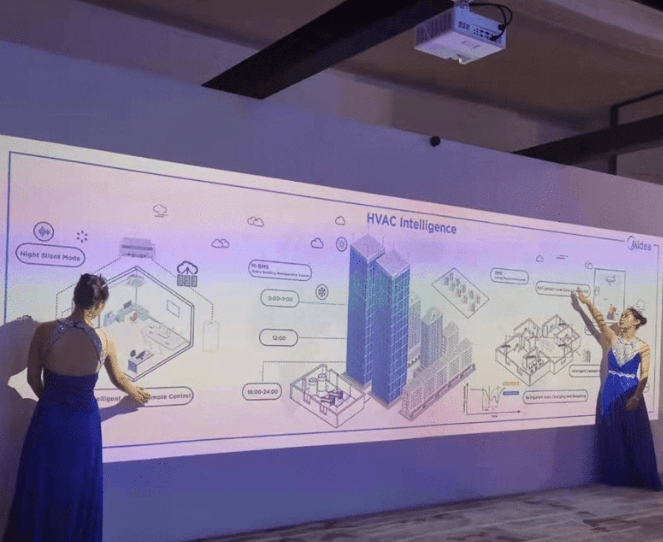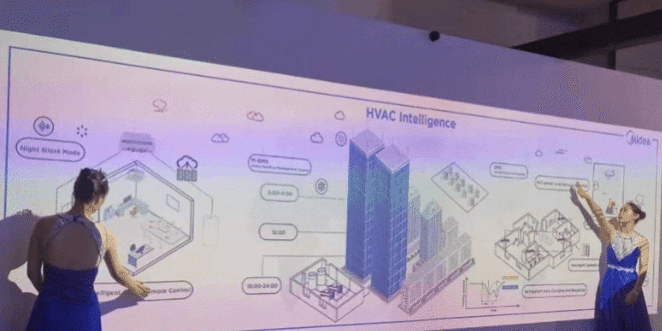Introduction
Modern museums are moving beyond static displays. With the rise of interactive projection technology, exhibitions are evolving into dynamic, engaging experiences where visitors don’t just observe—they participate. By combining projection mapping with interactive sensing systems, museums can create immersive journeys that inspire, educate, and entertain.
In this article, we’ll explore the features, applications, technologies, and benefits of museum interactive projection, and how manufacturers like CPJROBOT are helping museums achieve digital transformation through advanced POE LiDAR and intelligent robots.

What is Museum Interactive Projection?
Museum interactive projection is a multimedia display method that integrates projection technology with interactive sensing. Instead of passively viewing content, visitors can use gestures, touch, or movement to interact with projected visuals on walls, floors, or even 3D surfaces.
The result? A deeply immersive, participatory experience that makes history, art, and science more engaging and memorable.
Key Features of Interactive Projection
1. High Interactivity
Using technologies such as gesture recognition, motion capture, and touch sensors, audiences can directly engage with digital content. For example, waving a hand might reveal hidden details in an artifact, or stepping on the floor could trigger animations.
2. Immersive Experiences
Projections can cover walls, floors, or entire rooms, surrounding visitors with stunning visuals. Combined with sound effects, this creates a 360-degree sensory environment.
3. Diverse Content Formats
Interactive projections support videos, 3D animations, AR (augmented reality), and VR (virtual reality). This flexibility allows curators to bring creativity into exhibitions while enhancing storytelling.
Typical Applications in Museums
Cultural Heritage Restoration
Interactive projection can digitally recreate ancient ruins or historical events, allowing visitors to virtually “travel back in time” and better understand cultural heritage.
Artistic Expression
Artists increasingly use interactive projection to engage audiences as co-creators. Visitors can alter visual compositions in real time, making art more dynamic and personal.
Educational Tools
Interactive projections enhance guided tours and educational programs. Personalized digital storytelling makes complex topics accessible to all age groups.
Event and Theme Exhibitions
From temporary exhibitions to special events, interactive projection can transform museum spaces into unforgettable thematic environments.
Technology Behind Museum Interactive Projection
Projection Equipment
High-definition projectors—such as laser projectors and ultra-short-throw projectors—are essential for sharp, vivid visuals.
Sensor Devices
Motion detection and interaction rely on advanced sensors:
- CPJROBOT POE LiDAR for precise multi-point touch interaction and movement tracking.
- Cameras for gesture recognition.
- Pressure-sensitive floors for responsive ground projection games.
Software Platforms
Real-time image processing, 3D rendering, and interaction software manage seamless integration between hardware and content.
Advantages of Interactive Projection in Museums
- Enhanced Visitor Engagement: Active participation makes exhibitions more memorable.
- Flexible Customization: Content can be updated and reprogrammed with low maintenance costs.
- Stronger Attraction: Unique experiences attract more visitors and encourage repeat attendance.
- Cultural Innovation: Bridges the gap between traditional heritage and modern digital storytelling.
Frequently Asked Questions (FAQ)
Q1: What makes interactive projection different from traditional projection mapping?
Interactive projection allows real-time visitor participation, while traditional projection is static and pre-programmed.
Q2: Can interactive projection be installed in small museums?
Yes. The system is highly scalable, from small gallery rooms to large immersive halls.
Q3: How durable and reliable is the technology?
With industrial-grade sensors like CPJROBOT’s POE LiDAR and robust projectors, the system is designed for long-term operation in public spaces.
Q4: Is interactive projection expensive to maintain?
Not at all. Once installed, content updates are digital, making it cost-efficient compared to physical exhibit reconstructions.
Conclusion
Museum interactive projection is reshaping how cultural institutions connect with audiences. By merging storytelling, education, and interactivity, it brings exhibitions to life in unforgettable ways.
As a leading manufacturer of POE interactive LiDAR and reception/navigation robots, CPJROBOT provides cutting-edge solutions to museums and exhibition spaces worldwide.
Ready to upgrade your museum with immersive interactive projection?
Contact CPJROBOT today to explore customized LiDAR-based interactive solutions.







